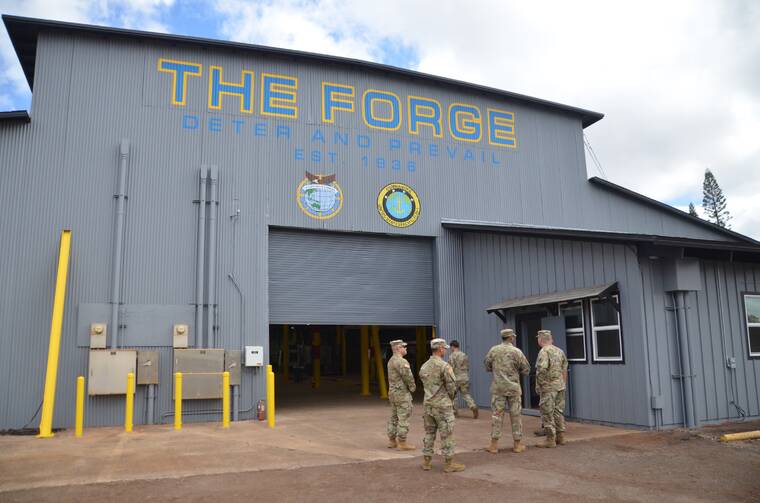Honolulu Star-Advertiser: Military, state leaders seek to train high-tech workforce

August 18, 2025
By Kevin Knodell
State and military leaders are hoping to start a “new industrial revolution” here in the islands with a focus on manufacturing and 3D printing tech.
Honolulu Community College on Aug. 6 unveiled a new Advanced Manufacturing Program Facility. The new training center is part of an umbrella of programs funded by the U.S. military to seed education and training programs in Hawaii for highly skilled industrial roles and train people how to use advanced new tools and techniques.
HCC Chancellor Karen Lee said “this training facility is truly state of the art, so we’re going to prepare the next generation of our workforce here in Hawaii.”
The new facility has $12 million worth of machines funded by the Office of Secretary of Defense’s Industrial Base Analysis and Sustainment program — or IBAS. As tensions have heated up in the Pacific amid tensions with China, the military is looking to find ways to manufacture more critical components for its weapons and equipment in the region, where commanders have long complained that supply chains are cumbersome.
The military has long struggled with what it calls “the tyranny of distance” in its Pacific operations, traveling across vast distances and needing to move supplies and equipment. When things break, getting replacement parts can take days, months or even over a year.
But advocates of the push toward manufacturing say they hope they can use the Pentagon’s funding to support initiatives well beyond military programs by creating a specially trained and capable workforce in Hawaii.
The Chamber of Commerce Hawaii’s 2030 Blueprint for Hawaii found that “Hawaii lags national employment growth in every sector and remains further below its pre-pandemic job level than all other states.” The report cited recent analysis by consulting firm Economic Leadership in which Hawaii ranked 48th of all states for manufacturing.
Lee said that “the importance of this facility is really to our Hawaii residents, so that we can upscale them for living wage jobs, whether as part of the (defense industry) or part of companies on island who need to manufacture parts quickly on island so you don’t have to wait a year for the parts to come.”
Benjamin Worrell, a Honolulu entrepreneur who serves as a strategic adviser to Naval Information Warfare Center Pacific, is one of the primary architects of the push to bring manufacturing to the islands to support military operations. Worrell told the Honolulu Star-Advertiser that in Hawaii “we don’t have an industrial base, most places do. So we had to create a workforce while simultaneously creating the industrial base.”
Worrell was put in charge of spearheading the program by Adm. Samuel Paparo, the top commander of U.S. military forces in the Pacific, after he recommended to Paparo when he was still commander of the U.S. Pacific Fleet that bringing manufacturing closer to American forces could remedy supply chain problems.
Paparo has spent years pushing to bring 3D printing and other tools into the region and loudly advocated for more. Earlier this year at the Honolulu Defense Forum, Paparo said in a keynote address “we need the capability to produce parts from propellers to circuit boards on demand. It isn’t future tech; it’s current capability … the technology exists, I’ve seen it. It’s here in Hawaii and we have to scale it.”
At Schofield Barracks, the military recently repurposed an abandoned, run-down warehouse building and turned it into “The Forge,” a manufacturing facility that can support troops in Hawaii and across the Pacific. It has on-site tools for 3D printing, precision machining, casting and forging and the ability for what they call “rapid prototyping.”
“Naval Information Warfare Center Pacific is sort of the day-to-day management, it owns all the machines here (at Schofield), owns all the machines down at Honolulu Community College, because in the time of need, we can activate those for wartime,” Worrell said. “If not, they’re there for the kids. And also, more importantly, is so I can spend (Department of Defense) funding to maintain them, calibrate them, and repair them.”
Worrell said that “what drives my heart fire is what we’re doing in the elementary schools, what we’re doing in the middle schools and what we’re doing in high schools (and) Honolulu Community College. When I first started this, I could never envision this. … We (in Hawaii) are now the benchmark for the rest of the country.”
Produced on the front
As workers have struggled in a changing economy both in Hawaii and the rest of the country, and as four-year colleges have become increasingly expensive, there has been renewed push to emphasize trade-school programs.
Matthew Draper, who works with the IBAS, said “we as our country have lost our way a bit. Instead of investing in manufacturing here in this country, we were the resource sponsor that built China as the world’s manufacturing floor. After the collapse in the Soviet Union, it was our money that rebuilt the Russian industrial base. And then we did something even worse: we convinced a whole bunch of kids, for an entire generation, that they were only of value if they got a bachelor’s degree.”
State leaders have long hoped to use military spending to help prop up Hawaii’s economy, but the relationship with the military has been complicated.
Last month the Honolulu Board of Water Supply filed a federal civil tort complaint in the U.S. District Court of Hawaii in which it said it is suing the Navy over its handling of the leaks at the Red Hill fuel storage facility, which sits just 100 feet over a critical aquifer most of Oahu relies on for clean water. BWS has estimated the cost of past, current and future impacts from the fuel leaks at $1.2 billion.
Military leaders have sought to highlight their spending and investments in Hawaii as they work through a series of land negotiations with the state on areas they see as critical for training and testing their weapons for a potential Pacific conflict.
Pono Chong works with an organization called Ku‘i Hao, which has been supporting the push for more manufacturing in Hawaii. The organization has been working with the Chamber of Commerce Hawaii’s Military Affairs Council, the Hawaii Defense Alliance, University of Hawaii and the state Department of Education.
Chong argued that while Hawaii already has several companies that do repairs and maintenance on ships and other military equipment, formal training and education for those jobs has been limited. He said new programs like the one at HCC can change that.
“There is no training like this right now,” he said. “So it helps to kind of provide that training. Because right now, if you talk to Marisco or (Pacific Shipyards International), they have to train that workforce. It’s strictly (on the job), right? Or you have to have education somewhere else. Now people can come here, they can get trained and then go out into the workforce.”
U.S. Sen. Brian Schatz, who attended the unveiling of the new HCC program, said “this is not the kind of pilot project that is designed to just scratch some political itch or demonstrate some possibility in the future. This actually meets a need, so that we don’t have to wait for a part from Germany or the continent coming from San Diego and taking two or three months to arrive. … Physical isolation is a challenge that is absolutely survivable, and we have among the most talented individuals, both in school or in the workforce, in the entire country.”
Reef Paiva, 19, will be among the first students to be trained in the program. He’s a 2023 graduate of Mililani High School and has been working at the Pearl Harbor Naval Shipyard as a junior “trainee helper.”
Paiva said he’s always liked working with his hands and worked on lifted trucks growing up. He told the Star-Advertiser that “right now at the shipyard I’m doing electrical, and I feel like machining is the future. So excited to do learn about machining and stuff.”
Made on demand
The military has already begun tinkering and experimenting with 3D printing and mobile manufacturing tools in Hawaii and across the Pacific.
During Exercise Rim of the Pacific 2024, several 3D-printing machines were brought to Hawaii to make replacement parts for ships and other vehicles. More recently during a deployment to the Philippines, members of the Schofield-based 25th Infantry Division brought 3D printers, which produced replacement parts. The printers also were used to make the components for small reconnaissance drones that were built and flown on the spot.
U.S. Sen. Mazie Hirono, who sits on the Senate Armed Services Committee, has backed Paparo’s push to invest in advanced manufacturing and 3D printing to support forces in Hawaii.
“(Paparo) is a risk taker, not in a dumb way, but to say, ‘why don’t we try this?’” Hirono said. “So when a ship is off at sea, for example, and needs a part, but they have to wait for the part to come, advanced manufacturing, 3D manufacturing, that kind of capacity is going to enable them to make the part onboard, saving time, saving money, and then it also creates new kinds of jobs for folks like this who will get to have that kind of training.”
At The Forge, troops have been testing out a range of new tech.
The warehouse that houses the machines was built in 1936. It was used as an Army horse stable and later became a maintenance facility for armored vehicles. After the Army got rid of its Stryker armored vehicles in Hawaii, it lay vacant for 13 years. When Worrell found it, it was overgrown with tall grass and had wild pigs living in it.
But he oversaw a hasty renovation program to get running. He estimates it’s only been working at its current capacity about four months. Worrell said “I was told to move fast, take more risks, because China wasn’t waiting.”
Scientists and engineers from the mainland have been in Hawaii teaching troops about the equipment and training them.
“This is an innovative experimentation, low rate of production facility,” Worrell said. “(It’s) to better inform the war fighter (and) better inform (the) industry of what works and doesn’t work. So we have some capabilities here that are the only ones in the world that exist. We have several that are out of national labs.”
At the site, soldiers and Marines worked with the machines both inside The Forge’s main building and out of shipping containers in the yard. Marine Sgt. Jackson Glassel said “all these systems can be containerized and be out in a different environment.” Glassel and a fellow Marine demonstrated an “expeditionary foundry” inside one of the containers, pouring molten metal into molds for heavy machine parts.
Army Chief Warrant Officer 5 Anthony Graveley showed off a part of a howitzer that soldiers made to replace one that had broken on one of their cannons. He said, “We broke this like the soldiers that we are — real fast in our exercise, within the first two weeks — and it remained broken an entire five months. (The replacement part is) on a boat right now, and it’s still broken. We broke it in April. It is now August. It’s still broken.”
“We made that (replacement part) in five hours,” Gravely said. “So if we had this capability (on deployment), imagine we’re in a situation where we need to regenerate combat power as fast as possible. I can get that gun back in five hours, as opposed to having it down for five months.”
See the story here.
